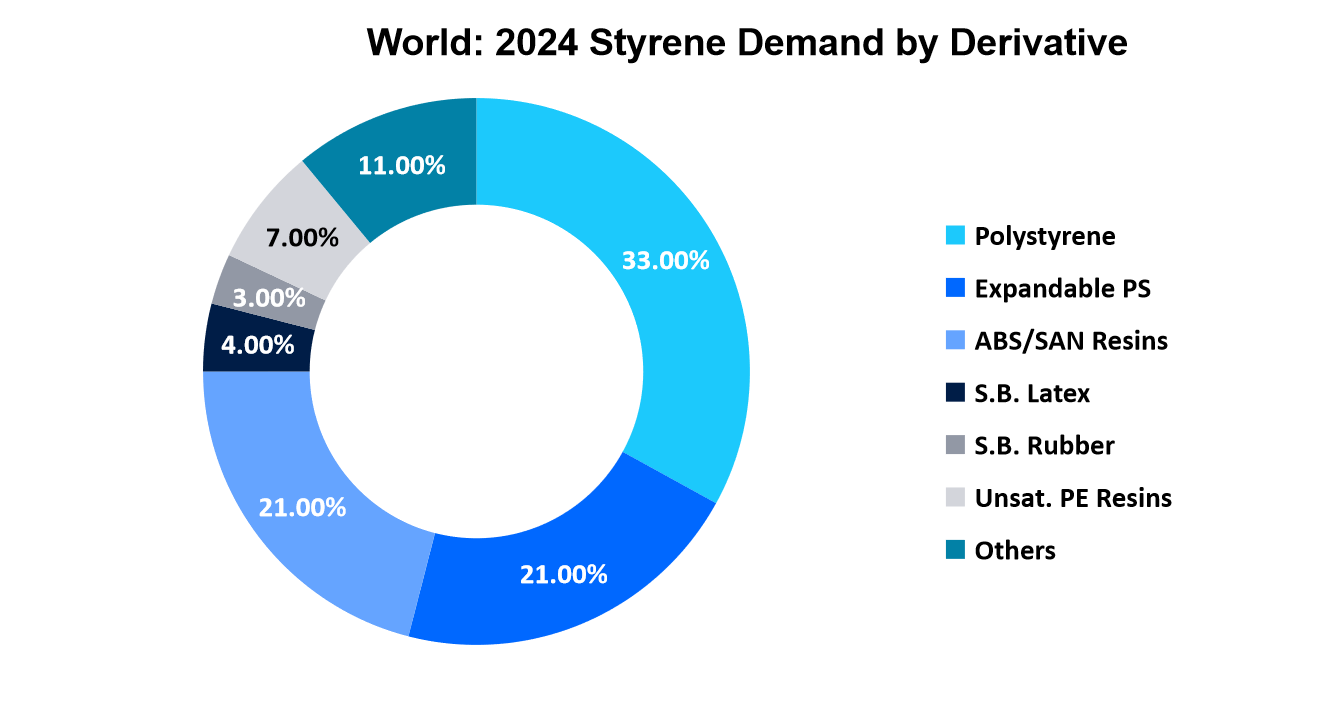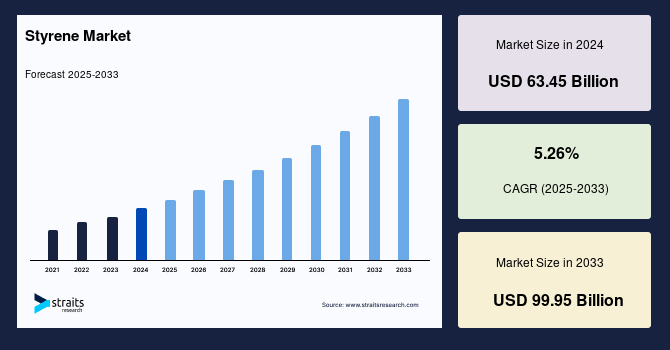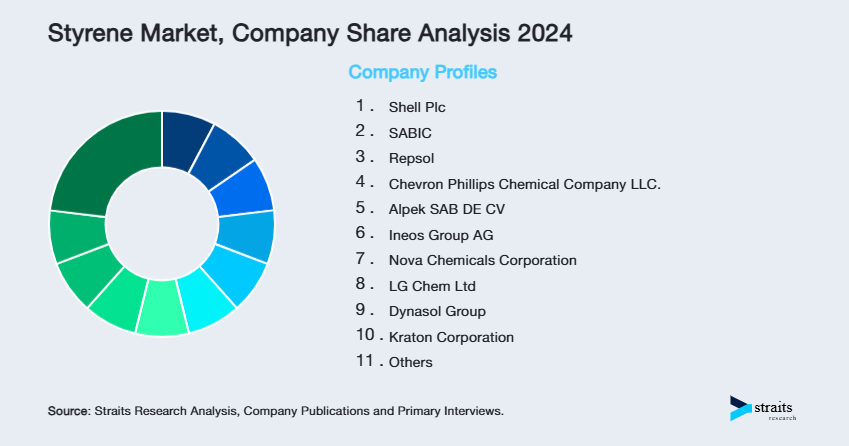Styrene Market Size
The global styrene market size was valued at USD 63.45 billion in 2024 and is expected to reach from USD 66.31 billion in 2025 to USD 99.95 billion in 2033, growing at a CAGR of 5.26% over the forecast period (2025-2033).
Styrene is an organic compound classified as an aromatic hydrocarbon with the chemical formula C₈H₈. It is a colorless, volatile liquid with a sweet smell and is primarily used to produce polystyrene, a widely used plastic material. Styrene is a key raw material in manufacturing various plastic and rubber products, including packaging materials, insulation, automotive components, and consumer goods. It also serves as a precursor for acrylonitrile butadiene styrene (ABS), styrene-butadiene rubber (SBR), and styrene-acrylonitrile (SAN), which are integral in multiple industries, including construction, healthcare, and electronics. The production of styrene involves the dehydrogenation of ethylbenzene, a process carried out in large-scale petrochemical facilities.
The global styrene market is influenced by trends in end-user industries, technological advancements in polymer science, and the growing demand for lightweight, high-performance materials. Innovations in bio-based styrene alternatives are also gaining traction as industries seek more sustainable production processes. The growing demand for packaging materials, increasing automotive production, and the rising need for durable and versatile plastics. Additionally, the construction industry's expansion and the demand for sustainable and lightweight materials contribute to the market's growth. Technological advancements in production processes and the recovery of styrene from renewable sources are also propelling market growth.
- In October 2024, according to the Global EPS Sustainability Alliance's (GESA) data summary, 72 nations pledged to recycle expanded polystyrene (EPS) transport packaging at different levels in 2023, and have attained more than 30% recycling rates.

Source: Straits Research
Emerging Market Trends
Growing Packaging Industry
Styrene is used in the packaging industry due to its favorable properties. Excellent clarity, impact resistance, and thermal insulation are all features of this lightweight, multipurpose plastic. It can be used in a variety of packaging applications. In the packaging industry, it is used to make polystyrene foam. Polystyrene foam is frequently used in protective packaging, such as lightweight shipping containers, insulation for perishable items, and cushioning materials. Additionally, rigid polystyrene, which is used in food packaging, is made from styrene. Because they are transparent and make it easy for consumers to see the contents, clear polystyrene containers like clamshells, cups, and trays are widely used in the food service sector. Furthermore, polystyrene is also used in the medical and healthcare industries for packaging applications.
- According to the Packaging Industry Association of India (PIAI), the Indian packaging industry is developing at 22.0% per annum and becoming a preferred hub. Furthermore, it is anticipated that the Indian packaging industry will grow at a compound annual growth rate (CAGR) of 26.7% from 2020 to 2025, reaching USD 204.81 billion.
Involvement of Manufacturers and Research Institutions in the Development of New Applications
Manufacturers increasingly invest in advanced technologies to innovate and optimize styrene-based products for various industries, including automotive, electronics, packaging, and construction. Research institutions play a role in exploring new formulations and sustainable alternatives, such as bio-based styrene and recyclable materials, to address environmental concerns. Collaborative efforts between industry leaders and academic organizations have led to the development of high-performance materials, expanding styrene’s applications in diverse sectors.
- According to industry publications, in 2021-2022, new factories for polystyrene and ABS plastics were expected to launch with a combined capacity of over 3.5 billion tons, including new facilities for companies like Sinopec Gulei, Zhejiang Petrochemical, and Shandong Lihuaya. However, a delay may be observed due to the country's energy crisis.

To get more insights about this report Download Free Sample Report
Styrene Market Growth Factors
Increased Popularity of Recycled Styrene
The growing emphasis on environmental sustainability has led to a heightened focus on recycling polystyrene to mitigate plastic pollution. Recycled styrene finds applications in products like foam packaging, light switches, and insulating plates, reflecting its versatility and the industry's commitment to eco-friendly practices.
- For instance, the French "Climate and Resilience" law initially aimed to ban styrene polymers and copolymers by 2025; however, this ban was postponed to 2030 in September 2024. This extension aligns with the European Union's Packaging and Packaging Waste Directive (PPWR), allowing manufacturers time to develop recycling channels that meet recyclability standards.
- By 2030, recyclable packaging is mandated, with industrial-scale implementation expected by 2035. Consequently, the demand for recycled styrene is anticipated to rise, driven by regulatory frameworks and a global shift towards sustainable materials.
Additionally, styrene-based materials, particularly polystyrene (PS), are extensively used in packaging due to their lightweight, durability, and cost-effectiveness. The global packaging industry's expansion, driven by e-commerce growth and changing consumer preferences, has significantly bolstered the demand.
Restraining Factors
Health and Environmental Concerns
The usage of styrene has raised significant health and environmental concerns. Exposure to styrene can adversely affect the central nervous and respiratory systems, leading to symptoms such as narcosis, nausea, depression, and fatigue. The International Agency for Research on Cancer (IARC) has classified styrene as a potential carcinogen, indicating its possible link to cancer with prolonged exposure.
Additionally, environmental issues arise from indirect photochemical reactions during styrene production, contributing to photochemical smog. These health and environmental risks have led to stringent regulations, compelling manufacturers to invest in eco-friendly technologies and processes, thereby restraining market growth.
- For instance, due to operational difficulties and regulatory worries about benzene emissions, German materials manufacturer Ineos Styrolution announced in October 2024 that it was permanently closing its styrene monomer production facility in Ontario, Canada.
In addition, the market is susceptible to fluctuations in the prices of raw materials such as ethylene and benzene, which are derived from crude oil. Volatility in crude oil prices directly impacts the cost structure of styrene production, affecting manufacturer profit margins. This unpredictability challenges pricing strategies and financial planning, potentially hindering market stability and growth.
Market Opportunity
Advancements in Sustainable Styrene Production
The increasing demand for green polymers presents a lucrative market opportunity for companies investing in sustainable styrene-based materials. Innovations in catalytic processes, artificial intelligence-driven quality control, and polymer modifications significantly enhance styrene-based materials' durability, flexibility, and overall performance. Manufacturers leveraging AI-powered analytics and machine learning algorithms can optimize polymer synthesis, reduce waste, and improve product consistency, aligning with the global shift towards sustainability.
- In June 2021, the styrene company INEOS Styrolution announced the release of mechanically recycled polystyrene in EMEA. This includes the development of a new Styrolution PS ECO 440 with the help of TOMRA's high-quality NIR sorting technology, which delivers pure polystyrene.
Additionally, rapid industrialization and urbanization in emerging economies have increased demand in various applications, including packaging, automotive, and construction. These markets offer significant growth potential for styrene manufacturers as infrastructure development and consumer goods consumption rise. Strategic investments and partnerships in these regions can provide companies a competitive edge, tapping into new customer bases and expanding market share.
regional Insights
North America: Dominant Region with Robust Market Growth
North America remains a key region in the global styrene market, driven by strong demand for sustainable and biodegradable alternatives, government regulations, and R&D advancements in eco-friendly styrene production. The region benefits from technological innovations and investments in circular economy initiatives. Companies are developing low-carbon solutions, ensuring that the automotive, packaging, and construction industries continue to rely on styrene while meeting sustainability targets.
- For instance, in September 2023, LyondellBasell launched its Low Carbon (LC) solutions, a new range of Intermediates and Derivatives (I&D) chemicals using recycled and renewable feedstocks. Certified by International Sustainability and Carbon Certification (ISCC) PLUS, these solutions provide a lower carbon footprint without compromising performance and application quality. The initiative aligns with corporate net-zero emissions goals and the growing demand for greener packaging, electronics, and construction materials.
Asia-Pacific: Rapid Expansion Fueled by Emerging Markets
Asia Pacific leads the global styrene market due to rising industrialization, urbanization, and infrastructure development. The region is home to key styrene consumers, including China and India, where expanding electronics, automotive, and construction industries fuel demand. Increased disposable income and shifting toward consumer electronics, household appliances, and lightweight automotive components further contribute to market growth.
- For instance, in May 2024, China's styrene imports reached 5,160.335 tons, bringing total imports for 2024-2025 to 120,213.306 tons. The country’s top five trading partners include Japan, Saudi Arabia, Taiwan, South Korea, and Malaysia.
Additionally, rapid technological adoption has increased the demand for styrene-based polymers like ABS, SAN, and PS, which are essential in TVs, laptops, smartphones, and home appliances. The rising demand for lightweight materials in the construction and transportation sectors supports styrene growth in Asia Pacific, particularly in China, India, and Southeast Asia.
As the region continues its economic and industrial expansion, major manufacturers invest in production capacity, recycling technologies, and sustainable solutions to maintain a competitive edge while addressing environmental concerns and supply chain challenges.
Countries Insights
- China: China remains the largest consumer and producer of styrene, driven by the rapid growth of its construction, automotive, and packaging industries. The rising demand for plastics, rubber, and coatings has fueled consistent import activity, making China a significant force in the global market. In May 2024, China's styrene imports were valued at USD 6.0952 billion, with an import volume of 5,160.335 tons, reflecting the region’s strong consumption requirement.
- Canada: Canada's market is bolstered by increased sustainability initiatives, government funding for green chemistry, and a growing demand for lightweight, high-performance materials in the construction and packaging sectors. The country has taken significant strides in polystyrene recycling, with various companies investing in eco-friendly processing and production methods.
- Indonesia: Indonesia's market is growing due to increased industrialization and demand for adhesives, coatings, and sealants. The country is also witnessing a surge in infrastructure development and a growing demand for construction materials made from styrene-based polymers. Additionally, government incentives to attract foreign investment in the chemical sector are fostering growth.
- South Korea: South Korea’s market benefits from the automotive, electronics, and packaging industries, playing a key role in global production. However, regulatory measures on emissions and supply chain disruptions have impacted production cycles. In March 2023, LG Chem, a leading producer, shut down its Yeosu-si (No.1 Plant) for 24 days and extended the closure of its Yeosu-si (No.2 Plant) until the end of March 2023.
- France: France’s market is transforming due to strict environmental regulations and sustainability policies. The country is a frontrunner in banning non-recyclable plastics, pushing manufacturers to develop recyclable and bio-based alternatives. In January 2022, INEOS Styrolution began producing 50,000 tons of ABS (Acrylonitrile Butadiene Styrene) in France, further expanding its product portfolio to cater to the demand for high-performance thermoplastics in automotive, electronics, and construction industries.
- United States: The U.S. market is heavily influenced by the demand for flexible packaging, automotive components, and insulation materials. The growth in e-commerce and food packaging industries has fueled the demand for lightweight, durable, and cost-effective packaging materials. According to Inforum's U.S. Census data analysis, the U.S. flexible packaging market generated USD 42.9 billion in sales in 2022, up from USD 37.2 billion in 2021, marking a 15.3% growth.
Styrene Market Segmentation Analysis
By Product
Acrylonitrile butadiene styrene (ABS) segments accounted for the most significant market revenue. The most popular technique for polymerizing ABS copolymer is emulsion polymerization. One well-known example of an emulsified substance is milk. ABS is also produced, but less frequently, using a proprietary process known as continuous mass polymerization. Additionally, ABS, a ubiquitous technical plastic used in luggage, pipe fittings, appliance housings, and interior automotive parts, is manufactured worldwide using emulsion. ABS is robust, durable, heat-resistant, and impervious to corrosive agents and physical impacts.
By Production Method
Ethylbenzene dehydrogenation segment captures the largest market share. This method involves the conversion of ethylbenzene to styrene by removing hydrogen, which is a relatively straightforward process that requires fewer raw materials. The EBD process offers high yield and selectivity for styrene, making it economically attractive. The process is well-established, with a wide array of plants operating globally, contributing to its dominant market presence. The method also benefits from advanced catalyst technology, improving the reaction rate and product quality. With the continuous demand in industries such as plastics and automotive, the Ethylbenzene Dehydrogenation method remains a preferred choice for large-scale production.
By End User
Packaging segment dominated the market with the largest market revenue. ABS is a typical material used to package skincare and cosmetic products. This is the widely utilized polymer in injection-molded tiny products, including bottles, mascara, eyeshadow, and lipstick tubes. ABS is an inexpensive, recyclable material with exceptional structural strength. Due to the amount of styrene, rigid ABS form develops a high gloss finish that looks opulent and appealing without further finishing touches. The best quality in terms of color, shine, and gloss can be obtained from ABS. Furthermore, it is commonly known that the remarkable chemical resistance of ABS polymer-based cosmetic containers allows them to function remarkably well at room temperature up to 30°C.
Company Market Share
The global styrene market is moderately partially fragmented. Companies operating in the market adopt strategies to maintain competitiveness and profitability. The strategy is product diversification, where companies develop and introduce various styrene derivatives, such as polystyrene, acrylonitrile butadiene styrene (ABS), and expandable polystyrene. Another critical approach is geographical expansion, wherein companies enter emerging markets where demand for styrene-based products grows. Additionally, investing in sustainable practices and green technologies has become crucial. This includes exploring bio-based styrene and recycling methods to meet the increasing demand for eco-friendly solutions.
Chevron Phillips Chemical Company LLC: An emerging player in the market
Chevron Phillips Chemical Company LLC (Chevron Phillips Chemical Company) produces chemical products and distributes petrochemicals. The Company offers styrene, cyclohexane, polystyrene, mining chemicals, benzene, olefins, polyolefins, aromatics, proprietary plastics, and polyalphaolefins. It serves customers worldwide and has 33 manufacturing and research facilities in seven countries. The company is a private company headquartered in Texas, United States.
List of key players in Styrene Market
- Shell Plc
- SABIC
- Repsol
- Chevron Phillips Chemical Company LLC.
- Alpek SAB DE CV
- Ineos Group AG
- Nova Chemicals Corporation
- LG Chem Ltd
- Dynasol Group
- Kraton Corporation
- Trinseo
- Elevate
- Hanwha Group
- Royal Dutch Shell plc
- Total SA
- ENI S.p.A

To get more findings about this report Download Market Share
recent Developments
- April 2024- To promote the commercialization of bio-isoprene monomers and sustainable aviation fuel (SAF), Zeon teamed up with Visolis. The goal of this partnership was to support Zeon's efforts to become carbon-neutral and promote a circular economy.
- July 2024- Through its Styron Receivables Funding Company, Trinseo partnered with KKR to obtain a USD 150 million non-recourse finance facility. Supporting Trinseo's expansion and capacity to provide vital commodities in several essential markets was the goal of the cooperation.
- July 2024- Versalis introduced new recycled polystyrene grades that satisfied requirements for food contact applications. By offering a more environmentally friendly option for food packaging, the project sought to improve sustainability in the use of plastic.
Analyst Opinion
As per the analyst, the global styrene market is experiencing steady growth, driven by its widespread use in various industries, including automotive, construction, electronics, and packaging. As a key component in the production of polystyrene, styrene is essential for creating products like insulation, packaging materials, and consumer goods. The demand for lightweight and cost-effective materials, which styrene-based products offer, influences the market.
Furthermore, the increasing adoption of styrene in automotive applications for interior parts and the growing construction industry further expand its market. However, fluctuating raw material prices, especially for benzene, and environmental concerns regarding styrene's potential health and environmental impacts pose challenges. Technological advancements in the production process and the development of sustainable alternatives are likely to shape the market's future dynamics.
Report Scope
| Report Metric | Details |
|---|---|
| Market Size in 2024 | USD 63.45 Billion |
| Market Size in 2025 | USD 66.31 Billion |
| Market Size in 2033 | USD 99.95 Billion |
| CAGR | 5.26% (2025-2033) |
| Base Year for Estimation | 2024 |
| Historical Data | 2021-2023 |
| Forecast Period | 2025-2033 |
| Report Coverage | Revenue Forecast, Competitive Landscape, Growth Factors, Environment & Regulatory Landscape and Trends |
| Segments Covered | By Product Type, By Production Method, By End User, By Distribution Channel, By Region. |
| Geographies Covered | North America, Europe, APAC, Middle East and Africa, LATAM, |
| Countries Covered | U.S., Canada, U.K., Germany, France, Spain, Italy, Russia, Nordic, Benelux, China, Korea, Japan, India, Australia, Taiwan, South East Asia, UAE, Turkey, Saudi Arabia, South Africa, Egypt, Nigeria, Brazil, Mexico, Argentina, Chile, Colombia, |
Explore more data points, trends and opportunities Download Free Sample Report
Styrene Market Segmentations
By Product Type (2021-2033)
- Polystyrene
- Styrene Butadiene Rubber
- Acrylonitrile Butadiene Styrene
- Styrene End User Outlook
By Production Method (2021-2033)
- Ethylbenzene Dehydrogenation
- Propylene Oxide Coproduct
- Others
By End User (2021-2033)
- Packaging Industry
- Automotive Industry
- Constructive Industry
By Distribution Channel (2021-2033)
- Online
- Offline
By Region (2021-2033)
- North America
- Europe
- APAC
- Middle East and Africa
- LATAM
Frequently Asked Questions (FAQs)
Anantika Sharma
Research Practice Lead
Anantika Sharma is a research practice lead with 7+ years of experience in the food & beverage and consumer products sectors. She specializes in analyzing market trends, consumer behavior, and product innovation strategies. Anantika's leadership in research ensures actionable insights that enable brands to thrive in competitive markets. Her expertise bridges data analytics with strategic foresight, empowering stakeholders to make informed, growth-oriented decisions.
Speak To AnalystAvailable for purchase with detailed segment data, forecasts, and regional insights.
Get This ReportOur Clients:










































